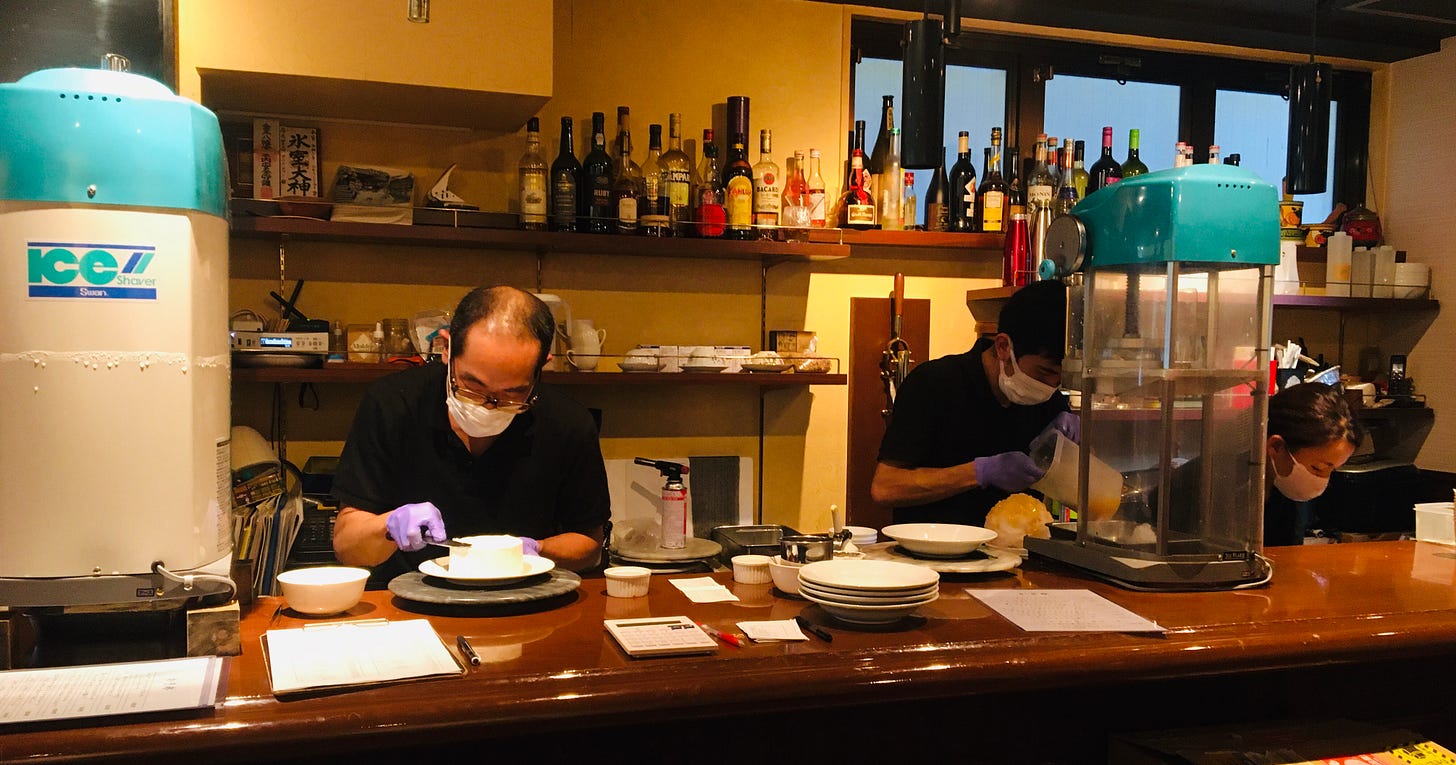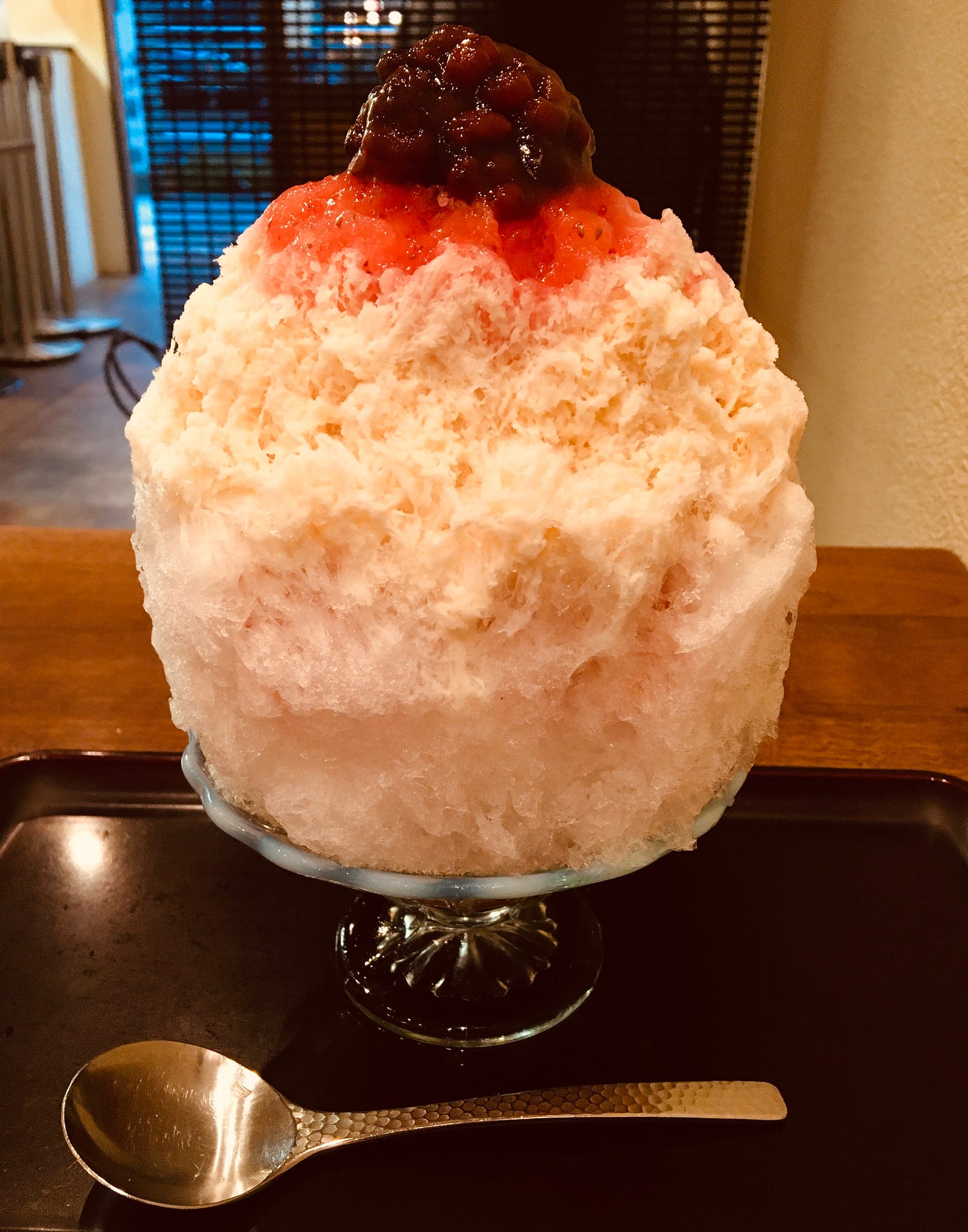Imagine trudging through a metropolis so hot and humid it feels like wading through a bowl of cream stew…even well after the sun sets. Now, imagine doing so day after day with a tight-fitting mask covering your nose and mouth.
This was my experience during a five-week trip to Tokyo in July and August of 2021.
Sweat-soaked and puffy from head to toe, I perpetually resembled a barbecued slab of unagi.
But I wasn’t about to let the fact I’m particularly ill-suited for tropical climates deter me from pounding the (scorching) pavement in search of tonkatsu sandos, paitan ramen, korokke, kare pan and the like; I just needed to find a reliable source of relief along the way.
While many Japanese opted for UV-coated parasols and portable cooling devices, I sought comfort in culinary form, with a classic treat known as kakigōri.
Kakigōri is a shaved ice dessert, drizzled with flavored syrups and sometimes accompanied by condensed milk, fruit, jellies and beans.
It’s in the same category as halo-halo, granita, Hawaiian shave ice, raspado, bingsu, sno-balls, etc., but it barely resembles the snow cones and italian ices of my childhood with their coarse texture and lab-manufactured flavors (like blue raspberry).
Kakigōri distinguishes itself by the exceptional consistency of its ice and the extraordinary quality of its toppings. In existence for more than a thousand years in a country known for its obsessive attention to detail, kakigōri is nothing short of a culinary masterpiece.
The ice for kakigōri (sometimes hand-carved, but more often produced by state-of-the-art machines) is otherworldly, at once fluffy and feathery. Eating the frozen delicacy is like biting into a pile of freshly-fallen snow; the ice melts away the moment it hits your tongue.
Artisans craft flavored syrups made from fresh, often locally-sourced, seasonal ingredients. Classic flavors include fruits like peach, melon, plum and strawberry along with matcha tea and brown sugar.
—
My first kakigōri was not hard-earned—I arrived by car from an air-conditioned office for a meeting at the five-star Palace Hotel—but it fueled my kakigōri obsession.
Near the end of a lunch meeting, our affable host Yamaguchi-san asked what foods we were most excited about sampling while in Japan. Everyone else named the usual suspects: tempura, ramen, sushi, yakitori.
My answer: kakigōri.
Yamaguchi-san let out a big belly laugh. “Kakigōri. Are you serious? How do you even know about kakigōri?
I explained that I had done a lot of food-centric research in preparation for my visit to Tokyo and that I was dying to try this sweet treat.
Still chuckling to himself, Yamaguchi-san remarked that the Palace had one of the best versions in Tokyo and immediately ordered a round for the table.
The confection was a sight to behold: emerald-green wisps of ice with matcha powder-encrusted edges, crowned with pearlescent rice-flour dumplings and gold leaf.
Yamaguchi-san implored, “Eat quickly before the ice starts to melt. Kakigōri waits for no one.”
The long, hand-cut strands of ice dissolved in my mouth, leaving behind their nutty essence. I would have been happy with spoonful after spoonful of the matcha ice, but several scoops in I hit upon a hidden pocket of partially-mashed azuki beans, silky and with just a hint of sweetness. Punctuated by chewy orbs of mochi, the dish was a textural marvel.
I looked around the table and saw the same blissed-out expressions on the faces of my colleagues. Much to Yamaguchi-san’s satisfaction, we were all hooked.
—
Several days later I set out to explore the Asakusa neighborhood, considered the heart of Old Tokyo, as a pretext to swing by the sweet shop Asakusa Naniwaya for a second kakigōri fix.
I caught a glimpse of myself in a window after hours spent wandering the streets of Kappabashi (aka kitchentown, the home of replica food and one of my favorite areas in the city) and the grounds of Sensō-ji in the blazing sun. My face was so heat-flushed I resembled the Niō figures guarding the temple.
Most people wouldn’t dare enter a place of business in such a state, let alone a food establishment; for me, it was kakigōri time.
I stepped inside the quaint shop and sat down at a table. I already knew my order: the asayake (morning glow), which depicts the sunrise atop Mt. Fuji. I needed more of those sweet azuki beans, which this shop cooks for eight hours as filling for their famed taiyaki (a waffle-like cake baked in a sea bream-shaped iron).
After ten minutes in a trance-like state the sunrise appeared before me: scarlet-hued beans atop a fireball of fresh strawberry puree bleeding into unsweetened milk syrup.
The structure of the ice differed from the rope-like shards I encountered at the Palace Hotel. This kakigōri resembled a powdery, slightly crunchy tower of snow, a perfect base for the blanket of syrup.
The interplay of the slightly-thick, sweet strawberry concentrate and the grassy milk was revelatory. Nesquik this was not.
Not only was it delicious, the kakigōri’s effect was magical: in a matter of minutes I felt refreshed and restored, ready to tackle the long walk back to my hotel along the Sumida river.
—
On my second to last day in Tokyo I covered a lot of territory: I ventured out to the charming neighborhood of Yanaka Ginza, through the narrow alleyways of Shinjuku’s Golden Gai district and into the chaotic scrum of Shibuya Crossing.
I detoured several times for a kakigōri break. After encountering hour-long waits outside of two kakigōri shops in two completely different areas of the city, I made one last-ditch effort at Sebastian, a popular purveyor (now closed) in Shibuya.
I was nearly delirious and completely haggard by the time I wandered in off the street. After settling in, studying the menu, and drinking several cups of water, a waitress came to take my order. She politely informed me it was a cash-only establishment (this is very typical in Japan).
“Fuck. Shit. Kuso tare (“dangling poop”),” I uttered to myself.
I had stupidly spent all of my cash in preparation for my return to the States. I apologized profusely, indicated that I had no cash, got up from my table and dejectedly stumbled out into the thick Tokyo evening.
I sat down on a rock and weighed my options. Did it make sense to take the equivalent of several hundred dollars out of an ATM for a 10 dollar kakigōri? Would I even be able to find an ATM that would accept my bank card?
I reached into my pocket to grab my handkerchief to remove the newly-formed sweat from my brow. A coin—Eureka!
I started rifling through my clothes and backpack, eventually dumping out the contents onto the street in utter desperation. (I’m sure anyone who’s ever been a slave to coin-operated laundry can relate). Miraculously, I scrounged up just enough yen for Sebastian’s base-level kakigōri.
I marched right back into the shop, announced I had located cash and ordered the peach kakigōri. [I have to give the waitress major props for keeping it together; she was definitely caught off guard but remained professional.]
The peach syrup was a little too sweet, the ice not as supple as in the other versions, but nevertheless, that first bite was pure triumph. Several bites in, that same magical effect began to take hold. My delirium started to fade and I felt a sense of calm.
I was determined not to leave Japan without tasting one more kakigōri and I had succeeded.
And with that I went back out into the night, ready to face the steam oven that is Tokyo.
All photos by Whitney Moeller unless otherwise noted.
If you enjoyed this post, please click on the heart button, share it with your friends and family or on social media.










Some people eat to live. The Moellers live to eat. I love the hilarious ending to this post.